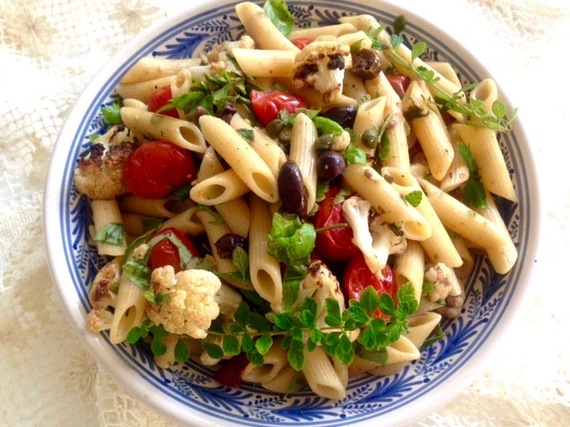Pantelleria has been discovered. This sleepy Sicilian island is suddenly hot thanks to A Bigger Splash.
But Pantelleria was here long before Tilda Swinton and Ralph Fiennes. It's an ancient island closer to Tunisia than Sicily. Volcanic, windswept Pantelleria seems barren, yet yields an abundance of olives, capers, grapes, tomatoes, citrus, almonds and herbs, the staples -- and the jewels -- of the Mediterranean Diet. And wow, what a coincidence, it's International Mediterranean Diet Month.
One of the oldest ways of eating, the Mediterranean Diet remains one of the healthiest and most vegan-friendly, relying on simple indigenous produce rather than meat or dairy. By both tradition and necessity, Mediterranean cuisine makes much from little, but there's nothing little about the flavors. Big, bold and elemental, Mediterranean cooking is what summer tastes like. It's one of the most luscious ways to eat, one of easiest cuisines to create at home. You don't need special kitchen appliances, you don't need exotic ingredients. The whole foods at its core-- whole grains, legumes, local produce, herbs, -- are foods that have sustained us, foods we've been hard-wired to love for millennia.
There are signs, though, that our wiring may be fraying. Speaking at Oldways' Common Ground , Dr. Antonia Trichopolou, one of Mediterranean Diet's earliest documenters and advocates, reported fewer and fewer people in the Mediterranean continue to eat that way. It's true in America, too. Ancient traditions and whole foods have given way to hectic modern life and processed food . . . and with them, the illnesses linked to diet and lifestyle choices.
It may be small and remote, but Pantelleria reflects a vast range of with culinary influences including Italian, Arab, Greek and Spanish. It's the whole Mediterranean Diet in microcosm, just as it's been for centuries. It was sexy and primal even without Tilda Swinton, Ralph Fiennes and a Stones soundtrack. But even Pantelleria isn't exempt from change, from losing what makes it precious.
The island -- and its foodways -- are worth preserving the way all ancient treasures are. Because they're beautiful, unique, they have a story to tell us about place, about history, about timelessness, about ourselves. And the fact that the Mediterranean Diet is deeply delicious and nourishing, cheap, easy and sustainable doesn't hurt.
The foods and foodways of the Mediterranean have always been hot. Especially during International Mediterranean Diet Month, they deserve a bigger splash.
Pantescan Pasta With Capers, Olives and Tomatoes
Sicily is famous for its sweet, abundant cauliflower. Pantelleria is famous for its capers. Capers are berries from a hearty shrub that thrives on this arid island. The jarred capers in stores are picked before ripeness, when they're tight little buds. They're then preserved in salt or brine. A scattering of capers imparts a natural, plant-based, fish-free flavor of the sea. Botanically speaking, though, capers are fruit. So are olives and tomatoes. These Pantescan fruits all come together with Sicilian cauliflower in this easy but primal pasta dish worthy of International Mediterranean Diet Month. Serve with a sexy, brash Sicilian vino rosso.1 pint grape tomatoes
2 cups cauliflower (about half a head of cauliflower), broken into small, bite-sized pieces
3 cloves garlic, minced
1/2 teaspoon dried red pepper flakes or 1 tablespoon fresh red chili, minced
1 tablespoon olive oil
1/3 cup white wine or vegetable broth
2 tablespoons kalamatas, pitted and chopped
1 tablespoon capers, rinsed and drained
8 ounces whole wheat penne or other short pasta
2 tablespoons fresh basil (from 1 good-sized sprig) coarsely chopped
2 tablespoons fresh flat-leaf Italian parsley (from 1 good-sized sprig),
coarsely chopped
1 tablespoon fresh thyme leaves (from 1 good-sized sprig) or
1 teaspoon dried thyme
1 tablespoon fresh oregano leaves or 1 teaspoon dried oregano
sea salt and fresh ground pepper
optional garnish -- a good handful of roasted, chopped almonds (another Pantescan crop) or
toasted breadcrumbsPreheat oven to 400 degrees.
Pour grape tomatoes and cauliflower pieces into an oven-proof casserole. Add minced garlic and chili flakes. Drizzle in olive oil and white wine or broth. Gently toss so cauliflower and tomatoes are coated.
Roast tomatoes and cauliflower for 30 minutes, stirring occasionally, or until tomatoes have blistered and popped and cauliflower has darkened in spots. May be done 2 hours ahead and kept, covered, at room temperature.
Bring a large pot of water to a boil. Add pasta and prepare according to package directions (tips from pasta pros here). Cook just until al dente. Drain pasta, reserving 1 cup of pasta cooking water.
Return the drained pasta to the pot. Add tomatoes and cauliflower, scraping in any accumulated juices. Pour in 1/4 cup pasta cooking water and stir. The starchiness of the pasta water will bond with the tomatoes to form just enough of a sauce to hug the pasta. For a saucier pasta, add additional pasta water 1/4 cup at a time to reach the desired consistency.
Scatter in chopped olives, capers and herbs. Toss gently to combine. Season with sea salt and pepper to taste.
Top with chopped roasted almonds or toasted breadcrumbs.
Serves 4.
More at soulfulvegan.com.



